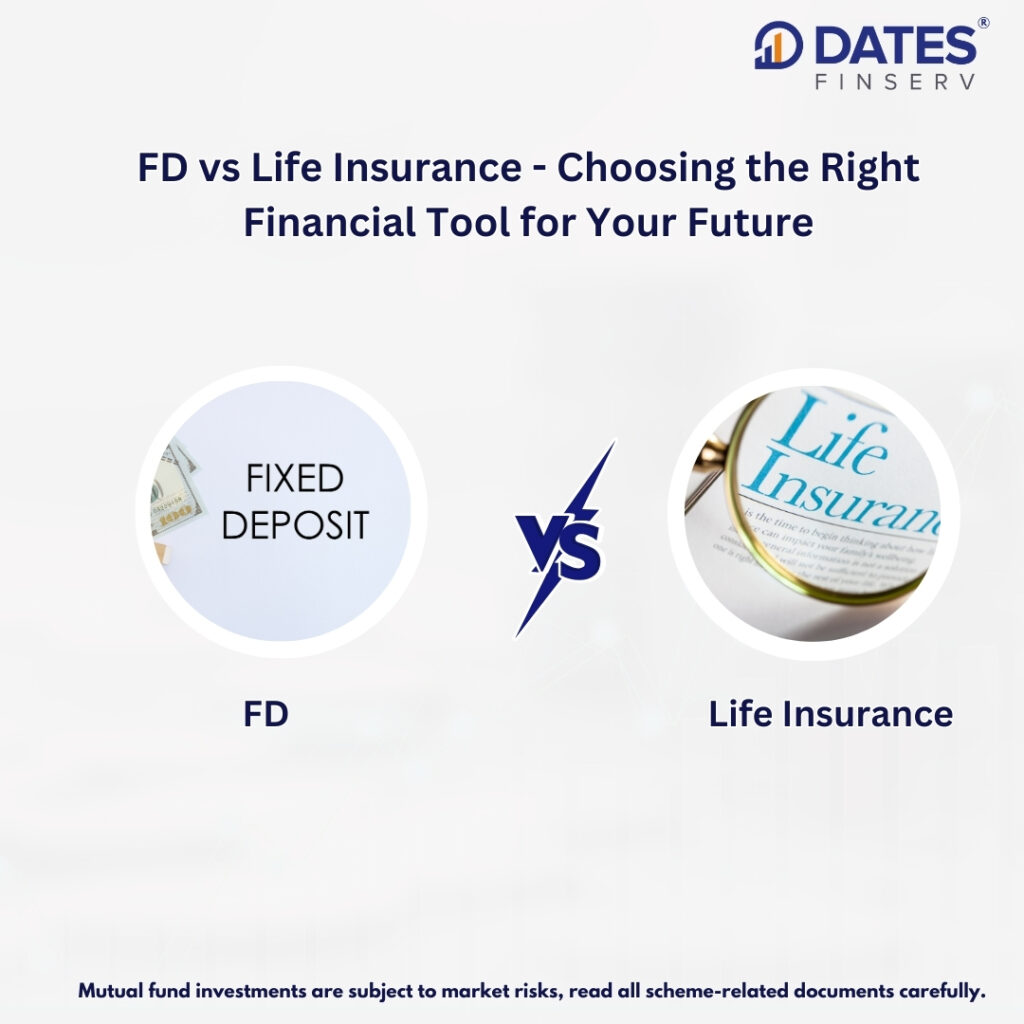When it comes to building a secure financial future, selecting the right tools is crucial. Two widely considered options are Fixed Deposits (FD) and Life Insurance. Both offer distinct advantages and serve different purposes, but understanding their differences can help you pick the one that best aligns with your financial goals. In this guide, we’ll explore the key aspects of FD and Life Insurance, making your decision easier.
What is a Fixed Deposit (FD)?
A Fixed Deposit, commonly known as FD, is a financial instrument offered by banks and financial institutions. Here’s a closer look at its workings:
- Guaranteed Returns: In an FD, you invest a fixed sum for a predetermined tenure. The bank pays interest on this amount at a fixed rate, ensuring that your returns are predictable.
- No Market Risk: FDs are immune to market fluctuations, which makes them a safe investment option. You know exactly what you’ll earn at the end of the tenure.
What is Life Insurance?
Life Insurance is primarily a financial protection tool for your loved ones in case of your untimely death. It provides a payout (known as a death benefit) to your beneficiaries. Additionally, some types of Life Insurance serve as investment tools:
- Term Insurance: Pure protection plan without an investment component.
- Whole Life Insurance: Coverage for the policyholder’s entire life with a savings component.
- Unit Linked Insurance Plans (ULIP): Investment-linked insurance, providing both protection and investment returns.
FD vs Life Insurance: Purpose
When comparing FD and Life Insurance, the primary difference lies in their purpose:
- FD: Ideal for people looking for short- to medium-term savings, guaranteed returns, and low risk.
- Life Insurance: Best for individuals seeking long-term financial protection for their families, often combined with investment goals.
Risk and Return Comparison
- FDs offer low-risk and fixed returns, appealing to conservative investors.
- Life Insurance has a varied risk level depending on the type. Term Insurance is low-risk, whereas ULIPs carry market-related risks.
Investment Horizon
Your investment timeline matters:
- FDs: Suitable for short- to medium-term goals. Most FDs have tenures between 6 months and 10 years.
- Life Insurance: Ideal for long-term commitments, particularly for those aiming for life cover with additional maturity benefits after a long tenure.
Liquidity
Liquidity refers to how easily you can access your funds when needed:
- FD: Premature withdrawals are possible but may incur a penalty.
- Life Insurance: Usually requires a lock-in period. Some policies allow partial withdrawals but only after a few years.
Tax Implications
- FD: Interest earned is taxable. However, tax-saving FDs with a 5-year lock-in qualify for deductions under Section 80C of the Income Tax Act.
- Life Insurance: Premiums qualify for tax deductions under Section 80C, and the payout (both maturity and death benefit) may also be tax-free under certain conditions.
Maturity Benefits
FDs offer a lump sum at maturity with pre-decided interest. Life Insurance, depending on the type, may provide maturity benefits, such as bonuses or accumulated funds, especially in ULIPs and endowment plans.
Premium and Investment Requirements
- FD: Flexible investment amount, depending on your preference and bank requirements.
- Life Insurance: Requires regular premium payments, which could be monthly, quarterly, or annually, based on the policy.
Loan Facilities
Both FD and Life Insurance policies offer loan facilities:
- FD: You can take a loan against your FD, usually up to 90% of the deposit amount.
- Life Insurance: Loans are available after the policy acquires a surrender value (for whole life or endowment policies).
Flexibility
FDs are typically more flexible, allowing easier early withdrawals (with penalty). Life Insurance policies often have a lock-in period and limited flexibility.
FD vs Life Insurance: Safety and Security
- FD: Highly secure, especially if held in reputable banks, covered under DICGC insurance up to a certain limit.
- Life Insurance: Also secure, as insurance companies are regulated by the IRDAI, ensuring strict oversight.
Inflation Protection
- FD: Often falls short against inflation, as fixed interest rates may not keep up with rising costs.
- Life Insurance: ULIPs and other investment-linked policies can offer returns that may outpace inflation, though they carry market risk.
Conclusion: Choosing the Right Option
The choice between FD and Life Insurance depends on your goals. If you’re looking for a safe place to grow savings for short-term needs, an FD is a solid choice. However, if your goal is long-term security with the added benefit of protecting your family, Life Insurance could be more suitable. Understanding your priorities will help you decide which financial tool to choose.
FAQs
- Is an FD safer than Life Insurance?
Yes, FDs are generally safer as they offer guaranteed returns with no market risk, whereas Life Insurance, especially ULIPs, can be influenced by market fluctuations. - Can I have both FD and Life Insurance?
Absolutely! Many people use FDs for short-term goals while investing in Life Insurance for long-term protection. - Which option provides better returns?
FDs provide fixed returns, while Life Insurance (particularly ULIPs) offers the potential for higher returns linked to the market, though with some risk. - Are there tax benefits for both FD and Life Insurance?
Yes. Tax-saving FDs and Life Insurance premiums qualify for deductions under Section 80C, but terms vary, especially for FDs. - Which is more flexible, FD or Life Insurance?
FDs offer more flexibility, especially in terms of early withdrawals. Life Insurance policies generally come with a lock-in period.
